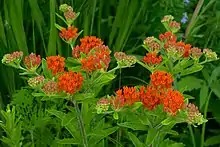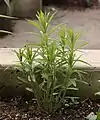Asclepias tuberosa
Asclepias tuberosa, the butterfly weed, is a species of milkweed native to eastern and southwestern[2] North America. It is commonly known as butterfly weed because of the butterflies that are attracted to the plant by its color and its copious production of nectar. It is also a larval food plant of the queen and monarch butterflies, as well as the dogbane tiger moth, milkweed tussock moth, and the unexpected cycnia[3] Hummingbirds, bees and other insects are also attracted.[4]
| Asclepias tuberosa | |
|---|---|
 | |
| Scientific classification | |
| Kingdom: | Plantae |
| Clade: | Tracheophytes |
| Clade: | Angiosperms |
| Clade: | Eudicots |
| Clade: | Asterids |
| Order: | Gentianales |
| Family: | Apocynaceae |
| Genus: | Asclepias |
| Species: | A. tuberosa |
| Binomial name | |
| Asclepias tuberosa | |
| Synonyms[1] | |
| |
Because of its rough leaves, Asclepias tuberosa is not a preferred host plant of the monarch butterfly but caterpillars can be reared on it successfully.[5] Further, it is one of the very lowest Asclepias species in cardenolide content, making it a poor source of protection from bird predation and parasite virulence and perhaps contributing to its lack of attractiveness to egg-laying monarchs.[6]
Description
It is a perennial plant growing to 0.3–1 metre (1 ft 0 in–3 ft 3 in) tall, with clustered orange or yellow flowers from early summer to early autumn. The leaves are spirally arranged, lanceolate, 5–12 cm (2" to 5") long, and 2–3 cm (about 1") broad.
Some wild plants have been reported to have orange flowers that are very reddish. It is uncertain if this is due to soil mineral content, ecotype genetic differentiation, or both. A cultivar, "Hello Yellow", typically has more yellowish flowers than ordinary examples of this plant.
Distribution and habitat
This plant favors dry, sand or gravel soil, but has also been reported on stream margins. It requires full sun.
Identification
The plant looks similar to the lanceolate milkweed (Asclepias lanceolata), but is uniquely identified by the larger number of flowers, and the hairy stems that are not milky when broken. It is most commonly found in fields with dry soil.
Propagation
Most easily propagated by seed. The primary pollinators are bees and wasps, rather than butterflies.[7] Sown outdoors after frost, a plant will flower and produce seed in the third year. Difficult to transplant once established.[8][9] In cultivation in the greenhouse, plants can easily be grown from seed to flowering in as little as three to six months.
Subspecies
- Asclepias tuberosa subsp. interior – (Central United States, Ontario and Quebec[10])
- Asclepias tuberosa subsp. rolfsii – Rolfs milkweed (Southeastern United States)
- Asclepias tuberosa subsp. tuberosa – (Eastern United States)
Common names
Common names include butterfly weed,[11] Canada root, chieger flower,[11] chiggerflower, fluxroot, Indian paintbrush, Indian posy, orange milkweed, orange root,[12] orange Swallow-wort, pleurisy root,[11] silky swallow-wort, tuber root, yellow milkweed, white-root, windroot, butterfly love, butterflyweed, and butterfly milkweed.[13]
Toxicity and uses
The plant contains toxic glycosides, alkaloids and resinoids which can cause weakness or seizures.[14]
Native Americans and European pioneers used the boiled roots to treat diarrhea and respiratory illnesses.[15] The young seed pods were used as food after being boiled in several changes of water.[15] The seed pod down was spun and used to make candle wicks.[15]
Use of the plant is contraindicated in pregnancy, during lactation or with infants due to its toxins, which include resinoids and pregnanes.[16] Because monarch butterflies do not favor it when reproducing, it is not as suitable for use in butterfly gardens and monarch waysides as are other milkweed species.[5][6]
Gallery
 Entire plant from the ground to the flower
Entire plant from the ground to the flower Young stems during spring
Young stems during spring A young leaf
A young leaf An emerging flower head
An emerging flower head Closeup of the hairy stems
Closeup of the hairy stems Closeup of unopened buds
Closeup of unopened buds Flower head
Flower head Closeup showing unopened, opening, and fully opened flower buds
Closeup showing unopened, opening, and fully opened flower buds Orange flowers
Orange flowers Red-striped orange flowers
Red-striped orange flowers Yellow flowers
Yellow flowers Seedpod
Seedpod
Footnotes
- "Asclepias tuberosa". World Checklist of Selected Plant Families (WCSP). Royal Botanic Gardens, Kew – via The Plant List.
- http://bonap.net/TDC/
- (1) The Xerces Society (2016), Gardening for Butterflies: How You Can Attract and Protect Beautiful, Beneficial Insects, Timber Press.
(2) Stevens, Michelle. "Plant Guide: Butterfly Milkweed: Asclepias tuberosa L." (PDF). United States Department of Agriculture: Natural Resources Conservation Service: National Plant Data Center. Retrieved September 11, 2020. Archived August 29, 2017, at the Wayback Machine. - Schillo, Rebecca (2011). Cummings, Nina (ed.). "Native Landscaping Takes Root in Chicago". In the Field. The Field Museum: 13.
- Gomez, Tony. "Asclepias Tuberosa: Butterfly Weed for Monarchs and More". Monarch Butterfly Garden. Retrieved September 11, 2020.
Rough leaves for monarch caterpillars, not typically a heavily used host plant
Archived August 16, 2017, at the Wayback Machine. - (1) "Milkweeds (mostly Asclepias spp.)". Alonso Abugattas Shares Native Plant Picks for Wildlife. Mid-Atlantic Gardener. 2016. Retrieved October 17, 2020.
And if you have hot, dry conditions in your yard, try Butterflyweed (A. tuberosa). .... It’s the least favored by Monarch caterpillars because it has very little toxin (cardiac glycosides) in its leaves.
Archived March 13, 2017, at the Wayback Machine
(2) Abugattas, Alonzo (January 3, 2017). "Monarch Way Stations". Capital Naturalist. Retrieved June 5, 2017 – via Blogger.(A. tuberosa) is the least favored by monarch caterpillars .... because it has very little toxin (cardiac glycosides) in its leaves, ....
Archived June 5, 2017, at the Wayback Machine.
(3) "Butterfly Weed: Asclepias tuberosa" (PDF). Becker County, Minnesota: Becker Soil and Water Conservation District. Retrieved September 11, 2020.Unlike other milkweeds, this plant has a clear sap, and the level of toxic cardiac glycosides is consistently low (although other toxic compounds may be present).
Archived September 11, 2020, at the Wayback Machine.
(4) Mikkelsen, Lauge Hjorth; Hamoudi, Hassan; Altuntas Gül, Cigdem; Heegaard, Steffen (2017). "Corneal Toxicity Following Exposure to Asclepias tuberosa". The Open Ophthalmology Journal. Bentham Science Publishers. 11: 1–4. doi:10.2174/1874364101711010001. PMC 5362972. PMID 28400886.The latex of A. tuberosa seems to be different from other members of the Asclepias family due to the fact that even though cardenolides are normally considered present in Asclepias species, these cardenolides have not been found in A. tuberosa. Instead some unique pregnane glycosides are found in A. tuberosa.
Archived September 11, 2020, at the Wayback Machine
(5) Warashina, Tsutomu; Noro, Tadataka (February 2010). "8,12;8,20-Diepoxy-8,14-secopregnane Glycosides from the Aerial Parts of Asclepias tuberosa". Chemical and Pharmaceutical Bulletin. Pharmaceutical Society of Japan. 58 (2): 172–179. doi:10.1248/cpb.58.172. PMID 20118575. Retrieved September 11, 2020.Though cardenolides are considered to be characteristic constituents of Asclepias spp. together with pregnane glycosides, we could find no cardenolides in the more hydrophobic fraction of the methanol extract of the aerial parts of A. tuberosa, the same as previously.
- Fishbein, M., and D.L. Venable. 1996. Diversity and change in the effective pollinators of Asclepias tuberosa. Ecology 77:1061-1073.
- Loewer, Peter 'Native Perennials For the Southeast' Cool Springs Press. Nashville, Tenn. 2005 ISBN 1-59186-121-7
- Druse, Ken 'Making More Plants The Science, Art, and Joy of Propagation' Abrams. New York, NY. 2012 ISBN 0-517-70787-X
- Species profile on VASCAN. Retrieved on February 21, 2018.
- "Asclepias tuberosa". Germplasm Resources Information Network (GRIN). Agricultural Research Service (ARS), United States Department of Agriculture (USDA). Retrieved December 17, 2017.
- anonymous (2008). "Featured Native Plant: Butterfly Weed" (PDF). Wild Ones: Native Plants, Natural Landscapes. 6 (4). Archived from the original (PDF) on August 14, 2014. Retrieved June 11, 2013.
- Dickinson, T.; Metsger, D.; Bull, J.; & Dickinson, R. (2004) ROM Field Guide to Wildflowers of Ontario. Toronto:Royal Ontario Museum, p. 138.
- Elias, Thomas S.; Dykeman, Peter A. (2009) [1982]. Edible Wild Plants: A North American Field Guide to Over 200 Natural Foods. New York: Sterling. pp. 267–68. ISBN 978-1-4027-6715-9. OCLC 244766414.
- "Butterfly Weed (Asclepias tuberosa)". tpwd.texas.gov. Retrieved March 6, 2019.
- (1) "Asclepias tuberosa". Native Plant Database. Lady Bird Johnson Wildflower Center, University of Texas at Austin. "Warning: POISONOUS PARTS: Roots, plant sap from all parts. Not edible. Toxic only if eaten in large quantities. Symptoms include vomiting, stupor, weakness, spasms. Toxic Principle: Resinoid, cardiac glycoside" Archived February 5, 2020, at the Wayback Machine.
(2) Mikkelsen, Lauge Hjorth; Hamoudi, Hassan; Altuntas Gül, Cigdem; Heegaard, Steffen (2017). "Corneal Toxicity Following Exposure to Asclepias tuberosa". The Open Ophthalmology Journal. Bentham Science Publishers. 11: 1–4. doi:10.2174/1874364101711010001. PMC 5362972. PMID 28400886.The latex of A. tuberosa seems to be different from other members of the Asclepias family due to the fact that even though cardenolides are normally considered present in Asclepias species, these cardenolides have not been found in A. tuberosa. Instead some unique pregnane glycosides are found in A. tuberosa.
Archived September 11, 2020, at the Wayback Machine
(3) Warashina, Tsutomu; Noro, Tadataka (February 2010). "8,12;8,20-Diepoxy-8,14-secopregnane Glycosides from the Aerial Parts of Asclepias tuberosa". Chemical and Pharmaceutical Bulletin. Pharmaceutical Society of Japan. 58 (2): 172–179. doi:10.1248/cpb.58.172. PMID 20118575. Retrieved September 11, 2020.
References
- Peterson, Roger Tory; Margaret McKenny (1968). A Field Guide to Wildflowers of Northeastern and North-central North America. Boston: Houghton Mifflin Company. ISBN 978-0-395-18325-0.
- Photo of a J.J. Audubon Plate Clay-Colored Sparrow perched atop Asclepias tuberosa
External links
| Wikimedia Commons has media related to Asclepias tuberosa. |
| Wikispecies has information related to Asclepias tuberosa. |
| The Wikibook Horticulture has a page on the topic of: Asclepias tuberosa |
- Butterfly weed brief information and pictures
- Missouri Botanical Garden Asclepias tuberosa
